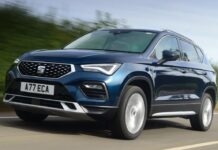The 2026 Kia Stonic is rolling into Australian showrooms with a significant refresh, but buyers will need to open their wallets a bit wider for the upgrades. Starting prices have climbed by up to $3260 compared to the previous model year, making it more expensive than its direct rival, the best-selling Mazda CX-3.
This updated version of Kia’s compact SUV boasts a new exterior design language, interior technology advancements, and an expanded mild-hybrid powertrain offering. While official detailed specifications are yet to be released by Kia Australia, early information reveals key changes across several areas.
A New Look Inspired By EVs
The most immediately noticeable change is the Stonic’s new look. Taking cues from Kia’s recent electric vehicle designs like the EV3 and K4, it ditches its predecessor’s rounded aesthetic for a sharper, more angular silhouette. This translates to a redesigned front end featuring Kia’s signature ‘Opposites United’ grille and headlights, along with updated rear styling including tail-lights, bumpers, and wheel designs.
Beyond aesthetics, the Stonic has grown slightly in length (by 25mm), reaching 4165mm overall, while boot space has also increased by 30 liters to a more practical 352 liters.
Tech Boost Across the Board
Inside, the 2026 Stonic welcomes a pair of large, high-resolution digital displays: a 12.3-inch instrument cluster and a matching infotainment touchscreen. Though these screens appear to run Kia’s older user interface rather than the newer ccNC system found in its latest EVs and larger models, they introduce Kia Connect services to Australia. This suite of cloud-based features promises real-time vehicle diagnostics, remote control functionalities via the Kia Connect app, and navigation integration for enhanced connectivity.
Other interior updates include redesigned climate control switches (multimode touch capacitive buttons similar to those found in the Sportage and Sorento), a revised center console, a new steering wheel, a repositioned gearshift, and conveniently placed USB-C charging ports.
Mild-Hybrid Powertrain Now Standard
Under the hood, the Stonic retains its familiar turbocharged 1.0-liter three-cylinder petrol engine. However, it’s now standard across the range with 48V mild-hybrid technology, a previously unavailable option for Australian buyers. This system increases power output to 84.5kW (up from 74kW), though peak torque remains unchanged at 172Nm.
Kia pairs this powertrain with a seven-speed dual-clutch automatic transmission; the six-speed manual is no longer offered. Acceleration has noticeably improved, dropping to 10.8 seconds for the 0-100km/h sprint (compared to 12.1 seconds previously).
Interestingly, despite the mild-hybrid system’s inclusion, fuel economy and CO2 emissions remain largely unchanged from the previous non-mild-hybrid engine, sitting at 5.6L/100km and 126g/km respectively.
Advanced Driver Assistance Features Added
Safety technology also receives a boost with the introduction of Kia’s Highway Driving Assist system. This semi-autonomous feature combines adaptive cruise control, lane centering, and navigation data to adapt speed automatically through curves, potentially easing long highway drives.
However, the full extent of additional safety features included in the updated Australian Stonic remains unclear pending official specifications release.
Competition Tightens
Kia Australia aims to capitalize on these upgrades as it faces increasing competition in the light SUV segment. While Kia has sold 5491 Stonics this year (placing it behind Hyundai Venue and just ahead of Mazda CX-3), both Korean models are dwarfed by the dominant Toyota Yaris Cross, highlighting the cutthroat nature of this category.
The arrival of the updated Stonic in Australian showrooms this month will provide further clarity on pricing, complete specifications, and feature availability, allowing potential buyers to make a more informed decision about whether this refreshed model justifies the price premium over its predecessor.




































